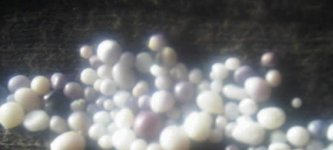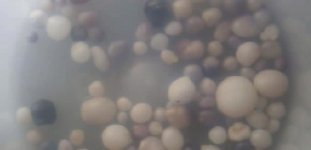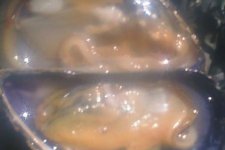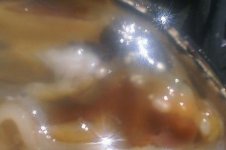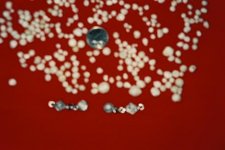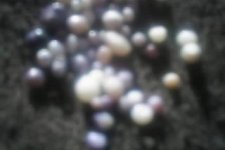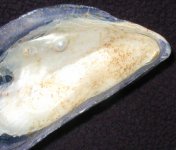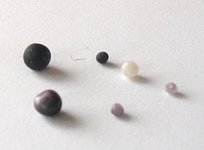S
You are using an out of date browser. It may not display this or other websites correctly.
You should upgrade or use an alternative browser.
You should upgrade or use an alternative browser.
Caitlin
Well-known member
Hi Eric
Thanks for your contributions.
If I am following this correctly, the mussels are mylitus edulis the common sea mussel. I googled it and did not get much.
This is a good description
They are common they are good to eat and there is little mention of their pearls, which is not surprizing as there isn't much mention of quahog pearls either, (though that is improving)
conchology inc has some for sale and a picture about halfway down the page. (and some fascinating unual pearls above it too-take a look-Lots of Atrina vexillum pearls on this page. Neverheard of them--Perlas and othrs from the Philippines I hope you will take a look at them. Have you ever seen them in person?
You may have the biggest collection of these in the world. . I think it wold be very interesting if you could keep following this up. Perhaps make a phone call or email to the local fish and game department? Your theory of how the pearls happens is interesting, but please don't stop there.
. I think it wold be very interesting if you could keep following this up. Perhaps make a phone call or email to the local fish and game department? Your theory of how the pearls happens is interesting, but please don't stop there.
I am looking forward to seeing the beds they grow in, though you should get a friend to take some pictures!
If it was an unusual event that caused this abundance of pearls in common sea mussel pearls, then you must take advantage of it and I am so glad you are.
I would like to see a couple in person. Also have you done any experiments like cutting one in half to see what it is like in the middle?
BTW you can reduce the big pictures right on your computer. Windows xp has a photo editor that is the default program for looking at pictures. It has a resize function. If you don't have xp, Paint does it too.
Thanks for your contributions.
If I am following this correctly, the mussels are mylitus edulis the common sea mussel. I googled it and did not get much.
This is a good description
They are common they are good to eat and there is little mention of their pearls, which is not surprizing as there isn't much mention of quahog pearls either, (though that is improving)
conchology inc has some for sale and a picture about halfway down the page. (and some fascinating unual pearls above it too-take a look-Lots of Atrina vexillum pearls on this page. Neverheard of them--Perlas and othrs from the Philippines I hope you will take a look at them. Have you ever seen them in person?
You may have the biggest collection of these in the world.
I am looking forward to seeing the beds they grow in, though you should get a friend to take some pictures!
If it was an unusual event that caused this abundance of pearls in common sea mussel pearls, then you must take advantage of it and I am so glad you are.
I would like to see a couple in person. Also have you done any experiments like cutting one in half to see what it is like in the middle?
BTW you can reduce the big pictures right on your computer. Windows xp has a photo editor that is the default program for looking at pictures. It has a resize function. If you don't have xp, Paint does it too.
S
scallop007
Guest
pearls in the shells
pearls in the shells
lets have a look at these, hope they come out,, hey thanks Caitlin,, the paint program works good ,lol thanks again ,,007
pearls in the shells
lets have a look at these, hope they come out,, hey thanks Caitlin,, the paint program works good ,lol thanks again ,,007
Attachments
Last edited by a moderator:
P
pierrettedE
Guest
Hi Eric,
I second Catlin about seeing these ... and since I'm less than 2 hours away...
Yes, the mussels he is speaking of should be mytilus edulis. There is an abondance of these. I have never seen or heard on them getting as light as those I see in the picture. Many look like Atlantic Scallop pearls, though I know you [Eric] know the difference.
We have a few species of freshwater mussels here too... I guess that's unrelated. It just crossed my mind how much fresh water actually gets into the Minas Basin.
Anyway. These mussels are prone to produce pearls. Though somewhat rare, considering the amount of mussels there are, they are much more common than in other types of our native bivalves, like scallops or quahogs and oysters. Their location and environmental conditions do influence pearl production. I think I've read that a parasite living in seagull f?ces might contribute to this.
As for the location of Eric's mussels.. ? ... there are veerrryyy long mud flats (very good clay for pottery , some of the highest tides in the world, warmer waters than in the open Atlantic. Am I correct?
, some of the highest tides in the world, warmer waters than in the open Atlantic. Am I correct?
For questions about recent surveys in that area, you could try the Bedford Institute of Oceanography.
I second Catlin about seeing these ... and since I'm less than 2 hours away...
Yes, the mussels he is speaking of should be mytilus edulis. There is an abondance of these. I have never seen or heard on them getting as light as those I see in the picture. Many look like Atlantic Scallop pearls, though I know you [Eric] know the difference.
We have a few species of freshwater mussels here too... I guess that's unrelated. It just crossed my mind how much fresh water actually gets into the Minas Basin.
Anyway. These mussels are prone to produce pearls. Though somewhat rare, considering the amount of mussels there are, they are much more common than in other types of our native bivalves, like scallops or quahogs and oysters. Their location and environmental conditions do influence pearl production. I think I've read that a parasite living in seagull f?ces might contribute to this.
As for the location of Eric's mussels.. ? ... there are veerrryyy long mud flats (very good clay for pottery
For questions about recent surveys in that area, you could try the Bedford Institute of Oceanography.
Caitlin
Well-known member
Eric
I can't see the purple pearl in there. darn. I am an old lady and everything looks blurry anyway, even without your photos adding to it! lol . Can you invite Pierrette to bring a camera for a field trip to the beds?
. Can you invite Pierrette to bring a camera for a field trip to the beds?
This is really interesting. I am wondering if some of them can be drilled or if they are all gooshy inside like quahog pearls? Since they are mussels, I would hope the pearls are nacreous concretions through and through.
Find a friend with a dremel (they can have very tiny drill bits or whatever they are called) and you will have a pearl ready to thread.
I can't see the purple pearl in there. darn. I am an old lady and everything looks blurry anyway, even without your photos adding to it! lol
This is really interesting. I am wondering if some of them can be drilled or if they are all gooshy inside like quahog pearls? Since they are mussels, I would hope the pearls are nacreous concretions through and through.
Find a friend with a dremel (they can have very tiny drill bits or whatever they are called) and you will have a pearl ready to thread.
S
scallop007
Guest
ah ,lol caitlin:: you got better vision than me no doubt he,he, ive done alot of squinting at sea, in the sun,, most of them are so small ya have to lick your finger to pick them up,lol they seem to be quite hard,some stuck to the shells just will not come off. hey check this pic out, its not very clear ,, these are scallop pearls from off of nova scotia we never save ,lol,, oh ps was reading about the diffrent glues,,,this is what can happen when you use crazy glue,, they are scallop pearls mounted in pewter the glue made it flat finished and i used way too much not realized untill the glue dried ,lol oh well,, dollar stores full of findings,, just have to melt out the plastic jewels ,lol
Attachments
Last edited by a moderator:
S
scallop007
Guest
S
scallop007
Guest
hi Caitlin: just checked out that site ,, wooo $20 for a 1.8 mm mussel pearl? and i've got a handfull of them,lol and the price of scallop pearls is even higher. if i got a buck a peice i would be happy,,thanks for the link,007
P
pattye
Guest
Eric & Pierette
Just wanted to say that I am enjoying this thread so very much, and following your enthusiastic pearling adventures on the beach!! Nova Scotia is beautiful and amazing place! Thanks for sharing it!!
pattye
Just wanted to say that I am enjoying this thread so very much, and following your enthusiastic pearling adventures on the beach!! Nova Scotia is beautiful and amazing place! Thanks for sharing it!!
pattye
P
pierrettedE
Guest
Hi Pattye  and spring is coming... !
and spring is coming... !
Eric, you might be taking the pictures too close. ? Try a few with the camera over 3 feet away. (just to try) Either that or find on the camera a setting called "macro" or MF and press it, click it, turn the nob to point at it,... you get the idea. If it's a nice -ish- day you can also try on a flat rock (grey is a good background) so that you don't need a flash.
just ideas ... not trying to be rude! .... i'm Canadian, I have to appologize for critical remarks you know!
Pierrette
Eric, you might be taking the pictures too close. ? Try a few with the camera over 3 feet away. (just to try) Either that or find on the camera a setting called "macro" or MF and press it, click it, turn the nob to point at it,... you get the idea. If it's a nice -ish- day you can also try on a flat rock (grey is a good background) so that you don't need a flash.
just ideas ... not trying to be rude! .... i'm Canadian, I have to appologize for critical remarks you know!
Pierrette
S
scallop007
Guest
the quest,,lol
the quest,,lol
hahahaha not rude at all. remember i'm a fisherman,lol i need all the help i can get. yes i'll try that .at least its a digital so i can retake. i'm getting good at that,lol your right about the dark background,,hey i took some of those photos on a brown cotton work glove, crude but effective,hehe ok thanks ,,the quest continues,,,,007 p.s.. thanks to everyone that has helped put this thread together. hi pattye; hope it's nice on the west coast,,,,thanks for the compliment,,
the quest,,lol
hahahaha not rude at all. remember i'm a fisherman,lol i need all the help i can get. yes i'll try that .at least its a digital so i can retake. i'm getting good at that,lol your right about the dark background,,hey i took some of those photos on a brown cotton work glove, crude but effective,hehe ok thanks ,,the quest continues,,,,007 p.s.. thanks to everyone that has helped put this thread together. hi pattye; hope it's nice on the west coast,,,,thanks for the compliment,,
Last edited by a moderator:
V
Valeria101
Guest
The blurry picture may be so because the camera was too close to the pearls.
Nonetheless, they are very interesting, and past the design hurdle to find a modern use for the various shapes, colors and small sizes, these pearls should turn attractive for anyone who cares about natural pearls!
Btw. about drilling them: a dentist's drill might do the trick, even a low tech version (ya know, the thinnest diamond drills used for deep ... forget it - it hurts to write!) If your dentist wouldn't bite, another might out of curiosity - I mean, what's not to like about drilling local pearls Besides, given the size and nature of the pearls, I would think that half drilling (for setting on pegs rather then stringing) make more sense, and those should be easier. Just a thought...
Besides, given the size and nature of the pearls, I would think that half drilling (for setting on pegs rather then stringing) make more sense, and those should be easier. Just a thought...
Nonetheless, they are very interesting, and past the design hurdle to find a modern use for the various shapes, colors and small sizes, these pearls should turn attractive for anyone who cares about natural pearls!
Btw. about drilling them: a dentist's drill might do the trick, even a low tech version (ya know, the thinnest diamond drills used for deep ... forget it - it hurts to write!) If your dentist wouldn't bite, another might out of curiosity - I mean, what's not to like about drilling local pearls
P
pierrettedE
Guest
hi,
not sure what you plan to do with all these, apart from saving them. Fancy Jewellers in Digby's been using scallop pearls so he can no doubt drill them. Not sure about the mussel pearls. I would think if you got a good graduation in size with some of those pretty purples, you could make an interesting piece!
I use a foredom drill, diamond bits with a GRS Benchmate system [sometimes my old adapted vice works too]. It works on scallop pearls, freshwaters and Tahitians. (I find the hardest are the Tahitians especially with some nuclei... but that's another story)
not sure what you plan to do with all these, apart from saving them. Fancy Jewellers in Digby's been using scallop pearls so he can no doubt drill them. Not sure about the mussel pearls. I would think if you got a good graduation in size with some of those pretty purples, you could make an interesting piece!
I use a foredom drill, diamond bits with a GRS Benchmate system [sometimes my old adapted vice works too]. It works on scallop pearls, freshwaters and Tahitians. (I find the hardest are the Tahitians especially with some nuclei... but that's another story)
P
pierrettedE
Guest
good morning. April 8 and 25 cm of snow! Easter... "argh not spring yet"
Here's my take [well, part-take. I still have to look again] on these blue mussel pearls.
I went for a visit to the Annopolis Basin yesterday. The tide was mostly high and I had my whole family. 3 girls: 7, 4 and 12mths! And my loving and obliging husband So you can imagine the data is rough!
So you can imagine the data is rough!
I spent about an hour on the shoreline behind CFB Corwallis. At first it looked like every other shell-litered beach, then my 4-yr-old plopped a large 4in half shell in my lap with 2 distinct pearls attached to the inside. This was followed by 3 others and a few heavily blemished &/or knarled [lacking more descriptive words] old shells. Eric mentioned marks of "pearl making". Yes, that is so. There are definitly outside conditions affecting these blue mussels. Either, parasite infestation or even strange run-off affecting growth. As I mentioned above, this was an army base for many years. The structures are still there and a very large cement pipe is still running to the beach where one can see many dead shells. Nah... some sort of boring-worm i think.? Blisters ('nacreous') are formed ... the full organisms make their way through without killing the host. Not immediately anyway since many pearls are found per mussel at times...
So, this was at high-ish tide inspecting old empty mytilus edulis shells. (yes, old shells become hosts to parasites. No, the damage to the shells was not post-m. The growth lines and structure of the shells were affected.)
Mud blister worm? hmmm maybeee > [Eric, have you seen bumpy parts on the shells that are brownish and not as hard as he pearls?] <
Shell-burrowing Sponges? hmm maybee ... combination worm? ... Red worm? don't think so... Flat worm? don't think so... Pea crab? no no...
This is becoming too long a post! Ok, comments?
Here's my take [well, part-take. I still have to look again] on these blue mussel pearls.
I went for a visit to the Annopolis Basin yesterday. The tide was mostly high and I had my whole family. 3 girls: 7, 4 and 12mths! And my loving and obliging husband
I spent about an hour on the shoreline behind CFB Corwallis. At first it looked like every other shell-litered beach, then my 4-yr-old plopped a large 4in half shell in my lap with 2 distinct pearls attached to the inside. This was followed by 3 others and a few heavily blemished &/or knarled [lacking more descriptive words] old shells. Eric mentioned marks of "pearl making". Yes, that is so. There are definitly outside conditions affecting these blue mussels. Either, parasite infestation or even strange run-off affecting growth. As I mentioned above, this was an army base for many years. The structures are still there and a very large cement pipe is still running to the beach where one can see many dead shells. Nah... some sort of boring-worm i think.? Blisters ('nacreous') are formed ... the full organisms make their way through without killing the host. Not immediately anyway since many pearls are found per mussel at times...
So, this was at high-ish tide inspecting old empty mytilus edulis shells. (yes, old shells become hosts to parasites. No, the damage to the shells was not post-m. The growth lines and structure of the shells were affected.)
Mud blister worm? hmmm maybeee > [Eric, have you seen bumpy parts on the shells that are brownish and not as hard as he pearls?] <
Shell-burrowing Sponges? hmm maybee ... combination worm? ... Red worm? don't think so... Flat worm? don't think so... Pea crab? no no...
This is becoming too long a post! Ok, comments?
Attachments
S
scallop007
Guest
seems to be only 1 type
seems to be only 1 type
good morning did you order up 5"of snow or what,lol up here it melted to about an inch not too bad in 6 hrs,,it must of blown 50 knots northerly yesterday. hey you were up and checked it out. i wish we could of met somewhere's could of showed you a whole handfull of those pearls over 2mm. got 17 out of one, the other night,1 almost 4mm. does'nt matter where i look (other than st mary's bay) they are in 4 out of 5,if you know which ones to look for ,,there seems to be about 4 diffrent kinds of mussels, only one kind has the pearls (or it so seems. the mussels with the white shells (st mary's bay) has very few,same with the mussels that has blue on the inside.the inside purple shelled ones have sometimes many pearls. alot i would not count just too small,, here's one,, the females(orange meats) have typically more pearls than the males(white meats) go figure,lol spawning makes the more weaker and open to infection??? who knows,, the ones i look for now are the ones that are dying(they are open alittle more than normal) they are invaded by little periwinkles.what a way to go,lol well better go feed the dragon another stick of wood have a great day pearler's ,,007
seems to be only 1 type
good morning did you order up 5"of snow or what,lol up here it melted to about an inch not too bad in 6 hrs,,it must of blown 50 knots northerly yesterday. hey you were up and checked it out. i wish we could of met somewhere's could of showed you a whole handfull of those pearls over 2mm. got 17 out of one, the other night,1 almost 4mm. does'nt matter where i look (other than st mary's bay) they are in 4 out of 5,if you know which ones to look for ,,there seems to be about 4 diffrent kinds of mussels, only one kind has the pearls (or it so seems. the mussels with the white shells (st mary's bay) has very few,same with the mussels that has blue on the inside.the inside purple shelled ones have sometimes many pearls. alot i would not count just too small,, here's one,, the females(orange meats) have typically more pearls than the males(white meats) go figure,lol spawning makes the more weaker and open to infection??? who knows,, the ones i look for now are the ones that are dying(they are open alittle more than normal) they are invaded by little periwinkles.what a way to go,lol well better go feed the dragon another stick of wood have a great day pearler's ,,007
V
Valeria101
Guest
The last image (the first detailed!) got me confused - it shows a lustrous, nacreous pearl... while the others images have made me believe that your pearls are of the non-nacreous type (looking like porcelain). Am I seeing things?
P
pierrettedE
Guest
hi, I was expecting non-nacreous pearls too. The ones I've seen before were of this sort. should be of this sort... AHhh i don't know. The inside of typical mussel shells are a little less lustrous than the few I found with blisters. The shells themselves were thicker also.
I'm wondering if the mussels are not m edulis... Eric sees a few different types, maybe he's right. Still wouldn't explain the lustre though, they look quite nice. Eric did mention in earlier posts that I had probably lost some lustre by steaming the mussels, but some i've seen weren't "cooked" ans were rather dull
time for a little research here...
I'm wondering if the mussels are not m edulis... Eric sees a few different types, maybe he's right. Still wouldn't explain the lustre though, they look quite nice. Eric did mention in earlier posts that I had probably lost some lustre by steaming the mussels, but some i've seen weren't "cooked" ans were rather dull
time for a little research here...
S
scallop007
Guest
i better hookup with you Pierrette and let you take some photos,in the mean time,i'll try to collect the diffrent kinds of shells maybe between all of us we can come up with something,lol.the hurtle i have is, there is really not any info on these,, maybe acadia or dalihousie they study marine bio.i'll keep looking,, good time for me to research and write a book,lol oh,,, there are some mussels that have bore holes, in those down behind Cornwallis. in the mouth of Bear River,, there are alot that has expired from over wintering sea birds, loons,ducks,gulls,eagles. the river is alive with mink and racoons and other predators, mortality rate is very high,, there is a bed of mussels there at low water,just to the right of the sand beach,where the point makes out behind the boat shed(where you were) thats must be 4 or 5 acres they only come out on the -0.0 low tides. example tides 28.8' high tide= -1.3' low tide. the higher they came in, the farther they go out. there is places the tide goes out for a mile,, 007
P
pierrettedE
Guest
good evening,
Try looking up "mytilus species" or nova scotia mussel species to see if you find any shells you recognize. To start, I think Mytilus Trossulus is around. Must be hybrids also.. might want to see if there are invasive species that have been noted. DFO may know this allready, Bedford Institute of O or St Andrews Lab
crying, screaming, not happy little baby! Mommy must tend!
little baby! Mommy must tend!

Try looking up "mytilus species" or nova scotia mussel species to see if you find any shells you recognize. To start, I think Mytilus Trossulus is around. Must be hybrids also.. might want to see if there are invasive species that have been noted. DFO may know this allready, Bedford Institute of O or St Andrews Lab
crying, screaming, not happy
P
pierrettedE
Guest
hello. It Sunday, April 15. Cold day here but we went for a walk on the beach again. This time in a cove here in our own harbour. I started at low tide and focused on older mussels that are near a warf founded in the 1800s. No one eats mussels from there.
We looked for older mussels with specific caracteristics: Thicker looking shells that looked very weather beaten even if solidly attached. The shells had to have severe "deformities" in growth structure.
We only picked 12 live mussel shells in all. This took about 2 hours, walking around, not wanting to pull and bull our way around! All shells were larger then 2in but smaller than 3in. We found 6 pearls. The sizes are small, 4 being less than 1.5mm (mostly whitish). one, however is around 2.5 (purple-blue) and the other is 3mm (deep blue-black).
They are all non-nacreous pearls. Not at all as lustrous as the little shell blister I posted above.
Though they are known to be somewhat more common than other bivalve pearls, it was still very interesting for a Sunday afternoon.
I will post a picture if I can get a decent one. (edit is the picture)
We looked for older mussels with specific caracteristics: Thicker looking shells that looked very weather beaten even if solidly attached. The shells had to have severe "deformities" in growth structure.
We only picked 12 live mussel shells in all. This took about 2 hours, walking around, not wanting to pull and bull our way around! All shells were larger then 2in but smaller than 3in. We found 6 pearls. The sizes are small, 4 being less than 1.5mm (mostly whitish). one, however is around 2.5 (purple-blue) and the other is 3mm (deep blue-black).
They are all non-nacreous pearls. Not at all as lustrous as the little shell blister I posted above.
Though they are known to be somewhat more common than other bivalve pearls, it was still very interesting for a Sunday afternoon.
I will post a picture if I can get a decent one. (edit is the picture)
Attachments
Last edited by a moderator:
Similar threads
- Replies
- 22
- Views
- 5K
- Replies
- 8
- Views
- 2K
- Replies
- 5
- Views
- 944

